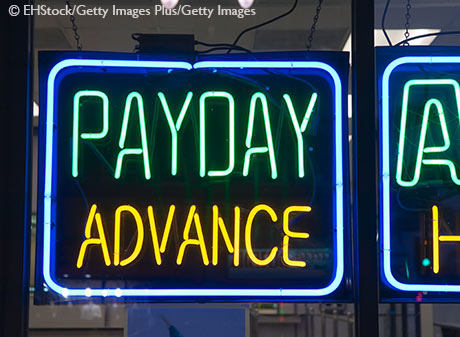How Payday Loans Work

Payday loans are different from other types of loans in one main way: They are short-term. Hence the name, they typically need to be paid back (plus fees) by the borrower’s next payday after the loan is made. This could be either a one-week, two-week or one-month period.
Unlike traditional loans, payday loans are unsecured, meaning that a borrower doesn’t need collateral to get one. Generally, credit reports and credit scores are not part of the loan process.
According to the Consumer Financial Protection Bureau, the requirements for qualifying for a payday loan include:
- An active account with a bank or credit union, or a prepaid card
- Proof of income from a job or other source
- Valid ID
- Being at least 18 years old
As many as 12 million Americans use payday loans each year, according to extensive research by the Pew Charitable Trusts. As previous St. Louis Fed research has noted, many people seem to have a love-hate relationship with them.
Fast Cash and Repeat Borrowing
Payday loans are marketed as a way of getting “fast cash” for emergencies or to meet short-term needs, but many people use them over and over to make up for cash shortage problems.
In a recent St. Louis Fed article, Senior Economic Education Specialist Jeannette Bennett explained that the most common users of payday loans include those with low incomes and higher-than-average poverty rates. According to Pew, three-fourths of all payday loans are taken out by borrowers who have already taken out 11 or more loans in a year.
One explanation for repeat use, Bennett said, is the fact that the loans are being used to pay for basic expenses. Pew says that as many as 58% of borrowers struggle to meet their basic monthly expenses, so, in reality, payday loans are often used for necessities like rent and utilities.
Another reason for repeat use is that an average loan requires a $430 payment on the next payday (per Pew) and most borrowers are not able to pay that and have to renew or re-borrow the loan. So, people need the loans but can’t afford them.
This leads to people getting caught in a cycle of debt: Each new loan leads to more fees, which can match or exceed the initial loan amount.
Calculating Payday Loan Fees and Interest
Payday loans may seem like an easy and fast solution to a short-term problem—needing fast cash—but they actually cost a lot more than traditional loans. The average interest rate on the average payday loan is a sky-high 391%, according to Bennett. That’s if it is paid after two weeks.
For comparison:
- As of early July 2019, the prevalent credit card interest rate was about 17.8%, according to Bankrate.
- According to economic data from the Federal Reserve Board of Governors, there was a 10.63% finance rate on personal loans at commercial banks as of May 2019.
Why are rates on payday loans so high? The fee-based structure. As Bennett points out, high lending fees due to the short-term nature of these loans make them expensive, as compared with other types of loans.
To calculate the APR, or annual percentage rate, of a payday loan, interest and fees for the amount borrowed are compared to what the cost would be for a one-year period. Consider this example, adapted from a St. Louis Fed economic education lesson called So How Much Are You Really Paying for That Loan? (PDF).
Example of a payday loan
Cecelia takes out a two-week payday loan in the amount of $400 to help pay for a car repair. The lender charges a $60 fee. What is the APR?
Step 1: Add all fees and interest charges to calculate total fees.
Total fees (given) = $60
Step 2: Divide the total fees by the amount financed (borrowed).
$60 / $400 = 0.15
Step 3: Multiply the answer by the number of days in a year: 365.
0.15 x 365 = 54.75
Step 4: Divide the answer by the term of the loan in days.
54.75 / 14 days = 3.91
Step 5: Move the decimal point two places to the right and add a percent sign.
Answer: 391% APR on this loan
Payday Loan Regulations
With the potential to create a cycle of debt, it may seem like the cons of using payday loans outweigh the pros.
For some consumers, payday loans can appear to be a convenient option. They offer fast cash with minimal documentation. They may be the only available loan source for people with low credit scores and those who cannot get traditional loans.
States are aware of the potential debt that can go along with payday loans, and each state has its own regulations. The rules can be very different depending what state you are in. Among other details, rules having to do with repeat borrowing, waiting periods between loans, and loan limits differ state-by-state.
Some states have downright outlawed payday lending. Seventeen states and the District of Columbia either prohibit it outright or set laws that have the same effect by running lenders out of business. (This was as of early 2019; state regulations continue to evolve). Consumer Financial Protection Bureau. “Consumer Financial Protection Bureau Releases Notices of Proposed Rulemaking on Payday Lending; Payday, Vehicle Title, and Certain High-Cost Installment Loans.” February 2019. (See reconsideration PDF.) In Missouri, payday lending is legal.
As far as federal regulation goes, the Consumer Financial Protection Bureau, or CFPB, was created in 2011 to protect consumers. The CFPB looks at payday lending practices and stays in touch with consumers, using this information to develop new federal regulations.
Conclusion
Love them or hate them? Payday loans can be helpful, but Bennett advises exercising caution when dealing with them.
“As with all forms of credit, borrowers need to be aware of what they are getting into when they take out a payday loan and avoid taking on debt they cannot afford,” she wrote, adding, that “Borrowing is costly without the power of knowledge.”
Notes and References
1 Consumer Financial Protection Bureau. “Consumer Financial Protection Bureau Releases Notices of Proposed Rulemaking on Payday Lending; Payday, Vehicle Title, and Certain High-Cost Installment Loans.” February 2019. (See reconsideration PDF.)
This blog explains everyday economics and the Fed, while also spotlighting St. Louis Fed people and programs. Views expressed are not necessarily those of the St. Louis Fed or Federal Reserve System.
Email Us


